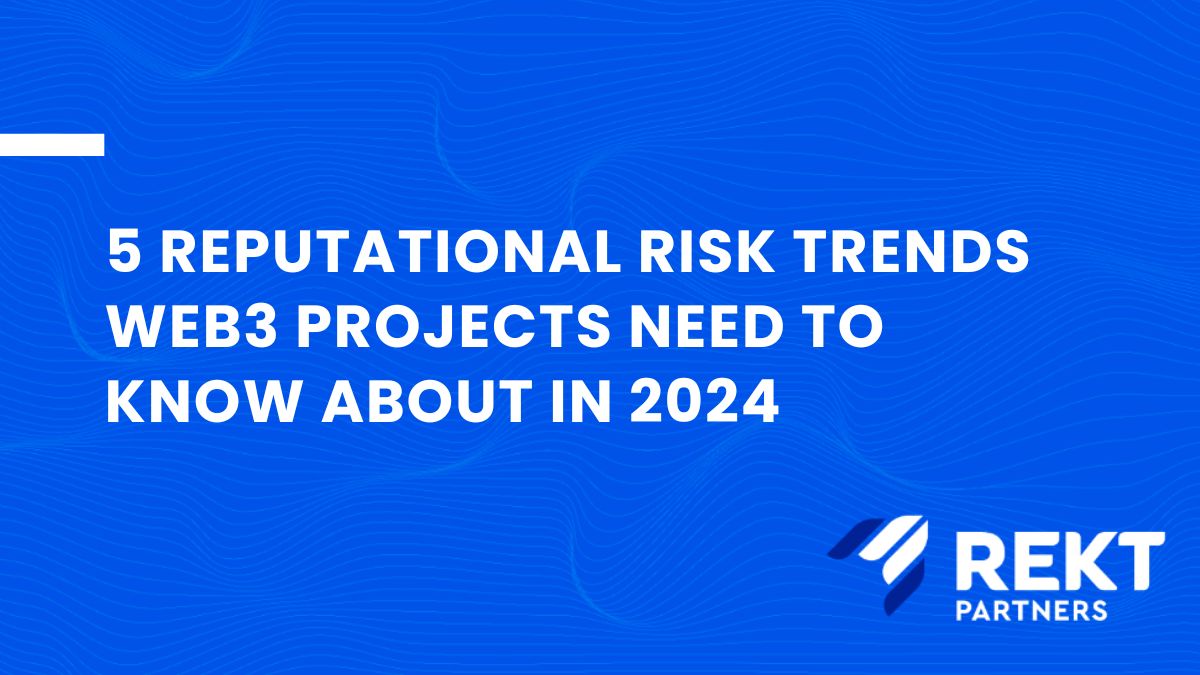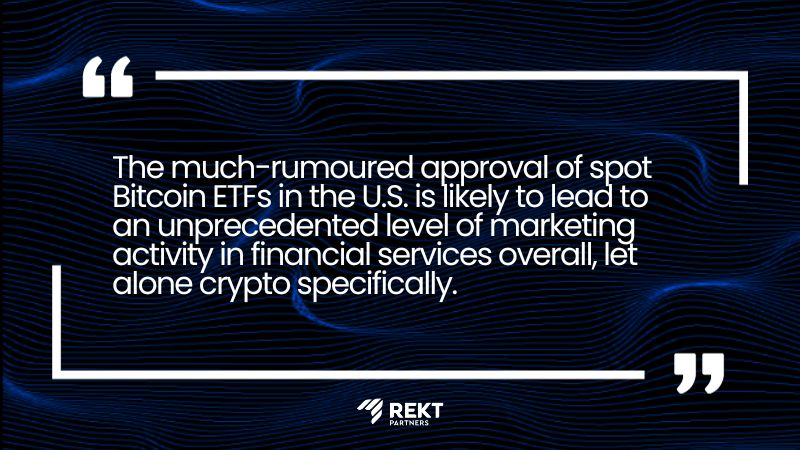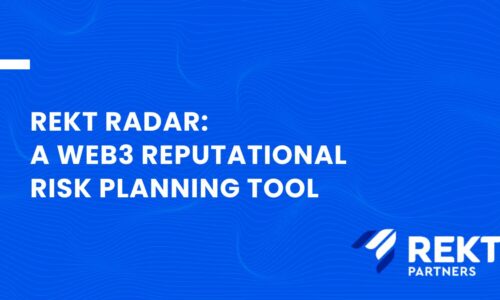5 Reputational Risk Trends Web3 Projects Need To Know About In 2024
- Jenny Hurley-Flynn
- December 19, 2023
- Risk planning
- 0 Comments

It’s been an eventful year in the world of Web3. With the Sam Bankman-Fried trial, high-profile regulatory action against Binance and the removal of CZ, as well as a whole host of scams, 2023 has been another year rich in reputational risk.
Lawsuits – including those relating to FTX, Coinbase and Binance – have dominated the headlines this year. It’s therefore no surprise that regulatory, legal and compliance risks were by far the most common reputational risk facing Web3 firms in 2023, making up nearly half (46%) of the risks tracked by our RADAR risk planning tool.
It’s not just crypto-focused titles that have covered issues in the space. Thanks in large part to the high-profile cases, mainstream media have become much more attuned to the crypto space and have moved their coverage beyond reporting on all-time high (and low) crypto prices. Speculation of ETF approvals in the U.S., as well as TradFi increasingly using blockchain technologies for upgrading legacy systems, such as settlement technology, is also driving interest from business-focused media.
Coupled with this, the crypto community has proved immune to Elon Musk’s involvement in Twitter, with its relevance as strong as ever — and providing constant fodder to journalists. Other popular social channels such as Telegram and Discord are also being increasingly scoured by reporters in search of a story.
This trend isn’t going away any time soon. With a lot of speculation and excitement about a 2024 bull run, the media will zoom in on the Web3 space even more closely. Web3 businesses therefore need to get a handle on their reputational risk landscape now and put communications strategies in place to mitigate their most critical risks.
While we don’t have a crystal ball, below are our thoughts on the areas Web3 businesses need to think about as they go into 2024. Of course, there are different nuances for the many subsectors within the Web3 ecosystem (our RADAR tool tracks over 40 of them), but we hope this article provides a good starting point for 2024 reputational risk planning.
Continued dominance of regulatory and legal risks

Regulatory, legal, and compliance risks are not going away anytime soon. Lawsuits have become an increasingly common headache for companies in this space, especially for centralised exchanges.
Companies with operations in the U.S. or without robust systems in place to block U.S. users are particularly exposed to legal risk and we envisage this trend continuing into the new year. Nearly half (49%) of all risks recorded by RADAR in the U.S. in 2023 were legal issues, highlighting just how dominant the issue is.
With the presidential election looming, we believe we will continue to see ‘regulation by enforcement’ in the U.S., which has been driven by the lack of a clear regulatory framework governing crypto and the Web3 ecosystem. Legislation to bring greater clarity to the U.S. will likely be stalled as the election process gets underway in earnest later next year.
In contrast, the EU’s passing of its MiCA regulatory framework was big news in the crypto world in 2023. As it starts to take effect from mid-2024, we expect a flurry of licence applications in EU jurisdictions.
Failed licence applications almost always attract the attention of crypto-focused media – not least because regulators are keen to show they are robustly maintaining standards. To mitigate the reputational fallout of this, Web3 firms seeking new licences should not only prepare messaging for all licence-related eventualities, but also focus on how they position their overall licence strategy. No single licence should be seen as critical to a project’s existence.
Bull market speculation driving scam-related reputational risk
The much-anticipated crypto bull market is, by many analysts’ predictions, due to take off in 2024 – and many are saying it has already arrived with the price action witnessed in the last quarter. But with the Bitcoin halving and the expected approval of spot Bitcoin ETFs in the U.S. early next year, there are strong fundamentals evident.
Unfortunately, bull markets bring with them yet more malicious actors seeking to exploit the fervent market environment. During these periods, the influx of new, often inexperienced investors presents an ideal target for various scams, exploiting the general lack of understanding of how cryptocurrencies work and the FOMO that grips many investors during these bullish periods. The number of rug pulls and scams is already nearing all-time highs, and we expect that number to rise in 2024.
The rise in scam-related activities likely to be triggered by a bull market can significantly amplify reputational risks for legitimate operators in the cryptocurrency space. Not only does an increase in scams tarnish the overall image of crypto, but they also leave legitimate businesses facing a trust challenge as they struggle to differentiate themselves from malicious actors.
To mitigate these risks, the first line of defence should be proactive and deliberate communication in advance of a crisis to build reputational capital and resilience – after all it is far more difficult to survive or recover from a crisis if your reputation is in tatters in the first place. This could be, for example, fostering a culture of education and awareness among their users and the wider public.
That said, it is also essential to have messaging and communications strategies prepared on the most likely and highest impact risks. Sadly, there is an air of inevitability that scams will strike so you are best to be prepared.
Product and marketing risks rising up the agenda

Product and marketing-related risks made up just 9% of the risks tracked by RADAR during 2023. However, given the possibility of a bull run and the corresponding market activity this will generate, we expect product-related risks to become more prominent during 2024. As predicted by The Pomp, the much-rumoured approval of spot Bitcoin ETFs in the U.S. is also likely to lead to an unprecedented level of marketing activity in financial services overall, let alone crypto specifically.
As market players seek to capitalise on bull market opportunities, we will see a glut of new products coming to market, which naturally leads to higher chances of product-related risk. The urgency to get innovations to market could result in hastily developed products that may not fully adhere to the robustness and security standards Web3 users (and regulators) expect.
To mitigate this risk, any Web3 product launch needs to have a communications plan in place that not only covers how to promote the product, but also how to communicate if the product does not work as expected. Web3 entities also need to think about how they communicate the sunsetting of products and avoid becoming overly focused on new product marketing.
Increased promotional activity also brings marketing risks. Key markets – including the UK – have started to be more prescriptive in how Web3 markets can market their products. We will likely see increased levels of enforcement action in 2024 for companies repeatedly violating the rules.
Community demands for more robust governance
As the Web3 space continues to evolve, we expect to see a growing focus on governance from both Web3 users and regulators.
From a user perspective, we anticipate increasing levels of interest in how DAOs are being run. Instances where DAO structures are opaque, biased or manipulated are likely to lead to widespread dissatisfaction among community members, causing not just an immediate backlash but also long-term reputational damage.
Given these stakes, Web3 firms with DAO ambitions need to approach their governance structures with meticulous care. This involves thoughtful consideration of how to structure their governance models to ensure inclusivity, transparency and fairness (including conducting all final proposal votes on-chain).
It’s also crucial that DAOs clearly communicate their governance procedures and the rationale behind them. This communication should be ongoing and evolve as the project and its community grow.
Having this backbone in place should mean DAOs are better placed to handle any high-profile disputes. As we saw with the recent Bankless DAO controversy, DAO-related disputes can quickly escalate into a full-blown reputational headache. As the Bankless team did, listening to your community, apologising when things have gone wrong, and taking action to address issues are key to limiting the reputational fallout.
Centralisation and censorship concerns

In 2023 we have seen growing concern around the levels of centralisation seen in some Layer 2 solutions within the Ethereum community. Censorship of some Bitcoin transactions is also increasingly irking crypto natives. The debate around both of these areas is expected to intensify in 2024.
From a reputational perspective, Web3 projects – particularly Layer 1 and 2 blockchains – have an increasingly difficult line to tread. On the one hand, they need to communicate with users who might be concerned about privacy and the operational issues that can arise with increasing centralisation. On the other hand, Web3 players are increasingly expected (and in many cases demanded) to engage positively with governments seeking to implement regulations in anticipation of increasing crypto adoption.
Having a clear vision and values – and communicating these effectively to different audiences – will be critical for Web3 companies seeking to navigate this complex landscape. As regulators become more embedded in Web3, they will seek to make more demands of blockchains and other Web3 players to censor transactions linked to nefarious activity.
Thinking about how to communicate with both users and regulators on these issues before they take place will help to limit any potential reputational impact. Communicating in an authentic and transparent way about any actions you’re taking to be a responsible player in the Web3 ecosystem by helping to stamp out nefarious activity will be important.
Conclusion – managing reputational risk in 2024
Reputation is a Web3 project’s most prized asset. Protecting reputation in this rapidly evolving space requires a proactive approach.
Conducting a risk audit is a critical first step in helping to ensure your reputation can weather any storm. This involves thinking about the risks that could impact your project, ranking those risks by likelihood and impact, and then putting messaging in place to address the highest-ranked risks. For maximum reputation protection, this process needs to be conducted on a quarterly basis.
None of us know what the future holds, but proactively considering your risk landscape and putting appropriate risk mitigation strategies in place will leave you much better placed to protect your reputation and help propel your project in 2024 and beyond.
Related Posts

- Jenny Hurley-Flynn
- October 5, 2023
REKT RADAR: A Unique Reputational Risk Planning Tool For The Web3 Space
REKT Partners is proud to unveil RADAR, our proprietary data-backed risk planning tool providin ..
